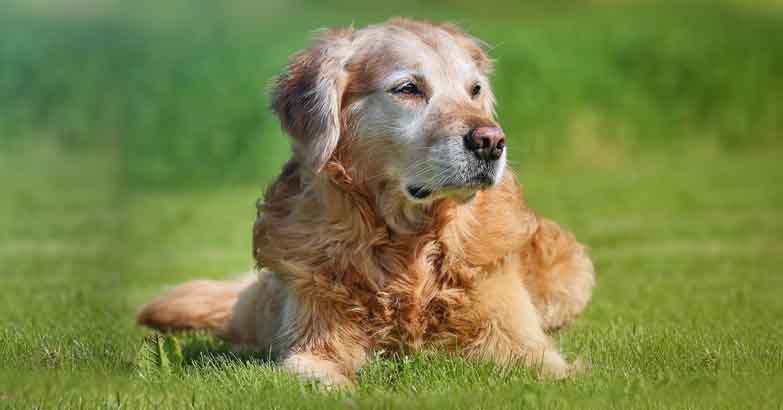Thyroid cancer in dogs is quite rare … but when it does occur, about 90% of cases involve malignant tumors.
Benign thyroid tumors are called adenomas, while malignant thyroid tumors are carcinomas and adenocarcinomas. About 75% of malignant thyroid tumors are “non-functional,” which means they don’t cause excessive hormone production.
What Is The Thyroid?
The thyroid is a butterfly-shaped gland at the base of the neck, beside your dog’s windpipe. The thyroid regulates the metabolism of cellular functions. The thyroid gland produces hormones like thyroxine (T4) and triiodothyronine (T3) which affect energy levels, temperature, hair, skin, and weight.
Symptoms Of Thyroid Cancer
What are the signs of a thyroid tumor in dogs? Often the first sign of is a lump in the neck. Other thyroid cancer symptoms may include:
- Breathing difficulty
- Coughing
- Hoarseness or change in barking
- Rapid breathing
- Gagging or difficulty swallowing
As mentioned earlier, only about 25% of malignant thyroid tumors affect thyroid function. But in those instances, other signs could be …
- Rapid heart rate
- Weight loss or muscle wasting
- Excessive thyroid hormone (shown on blood tests)
- Increased appetite
- Muscle tremors
- Excessive thirst and drinking
If you suspect thyroid cancer, take your dog to the vet right away. Thyroid tumors often spread rapidly to other body parts like the lungs and lymph nodes. They may also affect the windpipe, blood vessels and esophagus. In many dogs, thyroid cancer spreads first to the lungs, which are often already affected at diagnosis.
Causes Of Dog Thyroid Cancer
Specific causes of thyroid cancer in dogs are not known. Genetic tendencies appear to be the most common factor, and the breeds who seem most susceptible to thyroid cancer are Beagles, Golden Retrievers, Huskies and Boxers, usually between 9 and 11 years old.
How Is Thyroid Cancer In Dogs Diagnosed?
After a physical exam, your vet will perform lab work, including complete blood count, chemistry profile and urinalysis. A specific thyroid panel will show if the thyroid gland is hyperactive or functioning normally.
Most vets will recommend a fine needle biopsy of the tumor … but needle biopsies can be risky because they stir up cancer cells and cause them to spread. And in thyroid cancer, needle biopsies only diagnose about 50% of cases.
An ultrasound of the neck area can show the size of the tumor and whether it has spread to the lymph nodes. Chest x-rays are helpful to determine whether the tumor has spread to the lungs. Other imaging like MRIs or CT scans may also be helpful.
However, imaging tests won’t show microscopic spread of cancer to other internal organs like the lungs.
Conventional Treatment For Thyroid Cancer In Dogs
Conventional vets may recommend surgery to remove a thyroid tumor (thyroidectomy), and it can be quite successful. But only about half of all dogs with thyroid cancer are candidates for thyroidectomy. That’s because some tumors are attached to other tissues in the neck, and can’t be removed. Surgery is limited to tumors that are “freely moveable.” The risks of thyroidectomy include laryngeal paralysis, and excessive bleeding.
Radiation therapy is often used for thyroid cancer that has spread to other tissues. This can involve daily treatments 5 days a week, with as many as 21 treatments in all. Small repeated doses are thought to reduce radiation side effects. Most dogs have to be anesthetized for radiation therapy because they must be completely still, so the number of vet visits can be very stressful and greatly affect your dog’s quality of life. Side effects of radiation therapy like bone necrosis or damage to nerves and muscle can take 6 months or more to show up, but the damage is usually irreversible.
Stereotactic radiosurgery (SRS) is advanced radiation therapy that’s used in human cancers. It’s extremely precise, allowing it to destroy the tumor without harming surrounding cells. It involves fewer treatment sessions than conventional radiation, and side effects are less likely … and if they do occur, are treatable. Like regular radiation therapy, your dog will need anesthesia for this treatment, because even tiny movements can cause the oncologist to miss the tumor.
Chemotherapy is also often used, and while some thyroid tumors respond well, it appears less effective than radiation. The most common side effects are loss of appetite and vomiting.
Another treatment used for thyroid tumors is radioactive iodine, especially in cases where surgery isn’t feasible. However, it’s only offered in a few clinics because of high radiation doses needed, which are risky for clinic staffYour dog doesn’t have to be anesthetized for this treatment, but it usually involves a long (2 week) hospital stay to monitor your dog’s radiation levels so that it’s safe for him to be around your family. In some cases you can take him home for this period, but he must be confined separately and have minimal contact with you and other family members. Legally he mustn’t be around anyone who’s pregnant, or under 18. Radiation is expelled gradually in feces and urine.
Radioactive iodine treatment is also used to treat hyperthyroidism, where it’s 90% effective. However, the success rates are much lower in treating thyroid cancer. Sometimes cancer treatments fail, and often the cancer recurs. Side effects can include hypothyroidism or kidney failure.
Ir you’re considering chemo or radiation for your dog, read about some important questions to ask your veterinarian.
Natural Treatments For Dog Thyroid Cancer
Natural treatments for any kind of cancer are sometimes given as standalone treatments, or alongside conventional therapies.
Holistic practitioners usually focus on managing the health of the whole patient, supporting the body’s own ability to heal, while maintaining your dog’s quality of life.
Diet is the first step, and holistic vets will advocate whole food nutrition, avoiding starchy foods (like kibble) as well as synthetic supplements.
Do Dogs With Thyroid Cancer Need A Low Iodine Diet?
Human thyroid cancer patients often follow a low iodine diet … but only temporarily. It’s used in patients before and after receiving radioactive iodine treatments, because it’s thought to make the cells “hungry” for iodine, so the treatment is better absorbed.
So, unless you choose radioactive iodine treatment for your dog (which isn’t widely available), your dog doesn’t need to follow a low-iodine diet. In fact, iodine deficiency in dogs can lead to hypothyroidism, and may even be linked to some cancers.
Additional holistic therapies may include homeopathy, Chinese or western herbs, medicinal mushrooms, CBD, turmeric (or curcumin – the main component of turmeric), and other alternatives like mistletoe, ozone and essential oils.
If you choose natural therapies, always find a practitioner experienced in managing dogs with cancer. Here’s more detail on natural cancer treatments for dogs.
Dog Thyroid Cancer Life Expectancy
First, how long can a dog live with thyroid cancer without treatment? As mentioned earlier, thyroid cancers can spread quickly and are often hard to treat.
Sadly, dogs with untreated malignant thyroid tumors have an average survival time of only about 3 months. But this statistic likely only describes dogs who don’t receive conventional treatments. Natural treatments may offer better survival times because they support your dog’s overall health and his body’s own ability to heal.
Dogs with small, non-invasive tumors that haven’t spread can live 2-3 years if surgical removal is successful. Surgery does involve some risk, as mentioned earlier. The prognosis is better for thyroid tumors that are small and not invasive.
Life expectancy is limited in dogs with …
- Large tumors (defined as greater than 100 cm3), which have a 100% spread rate
- Bilateral or immoveable tumors
- Tumors that cause voice box paralysis
- Presence of measurable metastasis
Some studies show that radiation therapy may be more effective than chemotherapy. An Italian study published in 2023 analyzed 144 dogs who had thyroidectomies between 1994 and 2018. Median survival time was 802 days and 89 dogs survived for more than 500 days. Other factors that led to higher risk of death were thrombosis, non-follicular carcinoma and chemotherapy treatment. The authors noted that “adjuvant chemotherapy did not prove to be beneficial in affected dogs.”















